skip to main |
skip to sidebar
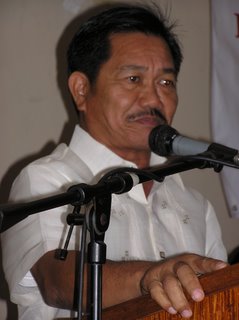 One of the fastest-rising provinces in the country is the former war-ravaged province of North Cotabato.From being one of the five poorest provinces in the country, North Cotabato is now ranked number twenty nine in terms of economic strength, a meteoric rise that spanned in just eight years.The man responsible for the economic boom of North Cotabato is a diminutive but brave Governor Emmanuel "Manny" Pinol, a former journalist and active sports commentator.
One of the fastest-rising provinces in the country is the former war-ravaged province of North Cotabato.From being one of the five poorest provinces in the country, North Cotabato is now ranked number twenty nine in terms of economic strength, a meteoric rise that spanned in just eight years.The man responsible for the economic boom of North Cotabato is a diminutive but brave Governor Emmanuel "Manny" Pinol, a former journalist and active sports commentator.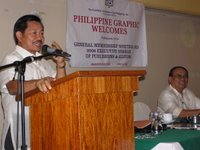 "Not long ago, North Cotabato has been known as a garbage dump. In this province you witness endless war between government troops and all types of rebels" Pinol said.It was not long ago that North Cotabato was the haven of practically all kinds of heinous crimes, ranging from kidnapping, ambuscades, extortion, murder---- you name it, Pinol added.
"Not long ago, North Cotabato has been known as a garbage dump. In this province you witness endless war between government troops and all types of rebels" Pinol said.It was not long ago that North Cotabato was the haven of practically all kinds of heinous crimes, ranging from kidnapping, ambuscades, extortion, murder---- you name it, Pinol added. But now, Pinol said he is proud to showcase North Cotabato was one of the fastest growing economy in the south.Despite being surrounded by rebel camps of the Moro Islamic Libereation Front (MILF), peace has reigned over the province.
But now, Pinol said he is proud to showcase North Cotabato was one of the fastest growing economy in the south.Despite being surrounded by rebel camps of the Moro Islamic Libereation Front (MILF), peace has reigned over the province. The only way to establish lasting peace is to eradicate poverty and want.Even a thousand peace agreements will not guarantee cessation of hostilities, if the stomach is hungry.That is why, Pinol explained, we will boost the province economy and make the lives of our constituents better.
The only way to establish lasting peace is to eradicate poverty and want.Even a thousand peace agreements will not guarantee cessation of hostilities, if the stomach is hungry.That is why, Pinol explained, we will boost the province economy and make the lives of our constituents better. 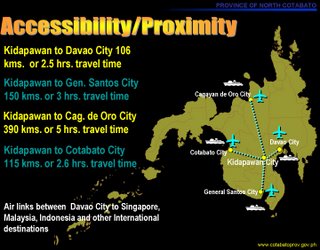 This is the only way peace can be achieved, Pinol stressed. Pinol disdains the centralized form of governmennt, saying this has contributed largely to the economic retrogession of many provinces in Mindanao.
This is the only way peace can be achieved, Pinol stressed. Pinol disdains the centralized form of governmennt, saying this has contributed largely to the economic retrogession of many provinces in Mindanao. People in imperial Manila have no idea on how to place our province on the path to progress. We have to chart our own destiny, Pinol maintains.
People in imperial Manila have no idea on how to place our province on the path to progress. We have to chart our own destiny, Pinol maintains. That is why he said he has adopted simple formula to remove North Cotabato from the list of poor provinces.Pinol emphasized that his province has adopted the policy of re-focused agrciulture.North Cotabato concentrates globally marketable agriculture. We have surveyed the most globally marketable agricultural products, and we concentrate on these, Pinol said.
That is why he said he has adopted simple formula to remove North Cotabato from the list of poor provinces.Pinol emphasized that his province has adopted the policy of re-focused agrciulture.North Cotabato concentrates globally marketable agriculture. We have surveyed the most globally marketable agricultural products, and we concentrate on these, Pinol said. Now, North Cotabato is one of the largest producers of banana, focusing on the Lakatan variety. Pinol reported that North Cotabato ships out more than a million tons of banana every week.Another major production of North Cotabato is rubber.
Now, North Cotabato is one of the largest producers of banana, focusing on the Lakatan variety. Pinol reported that North Cotabato ships out more than a million tons of banana every week.Another major production of North Cotabato is rubber.
Governor Pinbol said he is making a national advocacy for the propagation of rubber.
These are the money-making ventures in agriculture, not the planting of rice, corn and tomatoes, Pinol stressed.Pinol said he has focused on rural and countryside development by building farm to market roads so that the farmers will no longer be burdened of the difficulty of selling their produce.Pinol also said he believes in investing in education of the youth, as they will become the leaders of the future.An educated community will deter bloody conflicts, he explained.That is why the province has adopted a program of granting scholarships to talented children from North Cotabato, and sending them to top schools.After these children graduate, they will hopefully return and apply what they have learned, and become leaders in their respective home communities.Kidapawan City is the capital of North Cotabato.It is the haven of so many types of fruits like Rambutan, Pomelo, Durian, due mainly to the favorable climate which is conducive to growing fruits.The province of North Cotabato is a success story that continues to unfold, Pinonl said.He spoke recently before provincial newsmen and shared his story on how North Cotabato rose from the ashes of poverty.He delivered a power point presentation, detailing how in eight years, North Cotabato has become the one of the center of economic growths not only in Mindanao but the entire country .Also accompanying the governor was the runner up in the Miss Earth-Air, Miss Nadia Dela Cruz, who hails from North Cotabato.I brought her along to show that not everyone in North Cotabato is short, Pinol said.
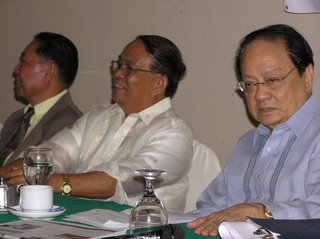 The Publishers Association of the Philippines Inc. (PAPI) a national organization of community newspaper publishers have elected their new set of officers who shall assume the next three-year term as mandated by their corporate by-laws.Juan Dayang, was re-elected Chairman-President of PAPI. His election was un contested.Dayang has been at the helm of PAPI for the last ten years. He has, on many ocassions singlehandedly steered the national organization, holding seminars for provinail newsmen, conventions, and discussions to promote the interests of community jounalism in the country.
The Publishers Association of the Philippines Inc. (PAPI) a national organization of community newspaper publishers have elected their new set of officers who shall assume the next three-year term as mandated by their corporate by-laws.Juan Dayang, was re-elected Chairman-President of PAPI. His election was un contested.Dayang has been at the helm of PAPI for the last ten years. He has, on many ocassions singlehandedly steered the national organization, holding seminars for provinail newsmen, conventions, and discussions to promote the interests of community jounalism in the country. 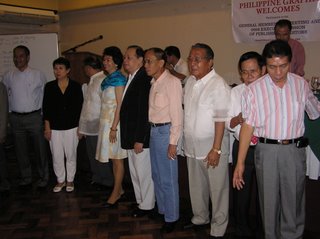 Meanwhile, the associate editor of the Negros Chornicle, lawyer Elmar Jay Martin I. Dejaresco was elected the youngest director of PAPI representing the Visayas.The new officers of PAPI who will be serving until 2009 are: Juan Dayang, President-Chair; Lelia Chua-Sy, Executive Vice President; Deo Alvarez, vice presidenti for Luzon; Danny Fajardo of Panay News, vice president for Visayas and Aznar, vice president for Mindanao.Secretary is Fred Gabot, Assistant Secretary, D.Y. Caparas. Ester Gallardo was elected treasurer while Phil Caracas was elected Auditor.
Meanwhile, the associate editor of the Negros Chornicle, lawyer Elmar Jay Martin I. Dejaresco was elected the youngest director of PAPI representing the Visayas.The new officers of PAPI who will be serving until 2009 are: Juan Dayang, President-Chair; Lelia Chua-Sy, Executive Vice President; Deo Alvarez, vice presidenti for Luzon; Danny Fajardo of Panay News, vice president for Visayas and Aznar, vice president for Mindanao.Secretary is Fred Gabot, Assistant Secretary, D.Y. Caparas. Ester Gallardo was elected treasurer while Phil Caracas was elected Auditor.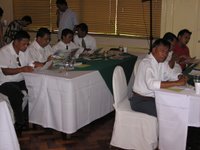 The directors are Mar Romero, Johnny Nunez, Edwin Pelayo, Elmar Jay Dejaresco, Vic Arevalo and Maureen Jones.The election of national officers of PAPI also coincided with the national convention of the group, which was attended by publishers from Luzon to as far as Sulu in Mindanao. Guest speaker during the national convention was lawyer journalist Napoleon Rama, publisher of the Manila Bulletin.
The directors are Mar Romero, Johnny Nunez, Edwin Pelayo, Elmar Jay Dejaresco, Vic Arevalo and Maureen Jones.The election of national officers of PAPI also coincided with the national convention of the group, which was attended by publishers from Luzon to as far as Sulu in Mindanao. Guest speaker during the national convention was lawyer journalist Napoleon Rama, publisher of the Manila Bulletin.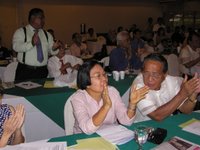 One of the advocacies of PAPI, which is being initated by Nap Rama, who started his journalism career as a columnist in Cebu, is to eliminate the legal requirement that newspaper publishers be mandatorily impleaded in libel suits agasint news reporters and editors.Juan Dayan announced that the next activity of PAPI is to hold an educational tour on August of the province of North Cotabato, upon the invitation of Govrnoer Emmanuel Pinol,himself a former journalist and an active sports commentator.
One of the advocacies of PAPI, which is being initated by Nap Rama, who started his journalism career as a columnist in Cebu, is to eliminate the legal requirement that newspaper publishers be mandatorily impleaded in libel suits agasint news reporters and editors.Juan Dayan announced that the next activity of PAPI is to hold an educational tour on August of the province of North Cotabato, upon the invitation of Govrnoer Emmanuel Pinol,himself a former journalist and an active sports commentator.
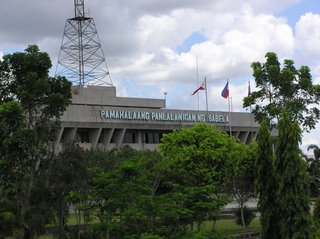 Yesterday Thursday, June 22, 2006, I travelled by land to Isabela Province to attend a court hearing.Ilagan Isabela is a good four hundred kilometers away from Metro Manila. Travel time was seven hours on a private vehicle.I woke up at 2 o'clock in the morning, to prepare for the long trip. My companion, Glenn the indefatigable, who drove me arrived a few minutes before 3 a.m.I had been planning to continue sleeping aborad the Nissan X Trail of Ping Remollo so I brought along a portable travel pillow.
Yesterday Thursday, June 22, 2006, I travelled by land to Isabela Province to attend a court hearing.Ilagan Isabela is a good four hundred kilometers away from Metro Manila. Travel time was seven hours on a private vehicle.I woke up at 2 o'clock in the morning, to prepare for the long trip. My companion, Glenn the indefatigable, who drove me arrived a few minutes before 3 a.m.I had been planning to continue sleeping aborad the Nissan X Trail of Ping Remollo so I brought along a portable travel pillow.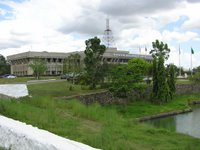 We took off and I listed the kilomtrage in the vehicle's odometer which was at 25,730. The gas gauge was full tank and Glenn said he poured in P1,800 worth of gasoline.Off we went. It was a smooth trip since there was no traffic snag and we were at the North Luzon Expressway at no time.I dozed off at around 4 a.m. and was in dreamland until 8 a.m. where we were already in Santiago Isabela.
We took off and I listed the kilomtrage in the vehicle's odometer which was at 25,730. The gas gauge was full tank and Glenn said he poured in P1,800 worth of gasoline.Off we went. It was a smooth trip since there was no traffic snag and we were at the North Luzon Expressway at no time.I dozed off at around 4 a.m. and was in dreamland until 8 a.m. where we were already in Santiago Isabela.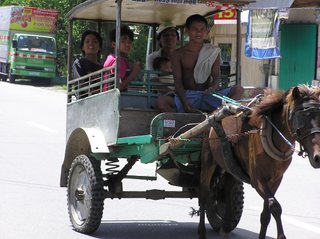 Santiago is at the southern tip of the province. IIagan, Isabela was still far away north of the province.In going to Isabela, we had to pass by Nueva Ecija, Nueva Vizcaya. We brought along a travel map to guide us on the towns we had to pass through, and to make a rough estimate of our travel time.We took breakfast in Santiago Isabela, at McDonalds, and proceeded immediately.The road to Isabela is surrounded by flatland. While going north, on teh right side is a sillhouete of the Sierra Madre. We arrived in Ilagan Isabela at exactly ten o o'clock and the odometer registered 26,100.
Santiago is at the southern tip of the province. IIagan, Isabela was still far away north of the province.In going to Isabela, we had to pass by Nueva Ecija, Nueva Vizcaya. We brought along a travel map to guide us on the towns we had to pass through, and to make a rough estimate of our travel time.We took breakfast in Santiago Isabela, at McDonalds, and proceeded immediately.The road to Isabela is surrounded by flatland. While going north, on teh right side is a sillhouete of the Sierra Madre. We arrived in Ilagan Isabela at exactly ten o o'clock and the odometer registered 26,100.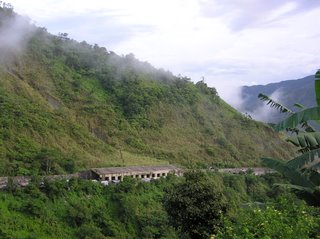 To our dismay, I learned that the court hearing, which was scheduled at 2 p.m. had been cancelled as the new permanent judge was yet to assume on Monday. The pairing (temporary) judge said he no longer would be holding hearings at branch 17 of the Regional Trial Court.Since we had nothing to do, I contacted the lawyer for the adverse counsel.He told me he was attending a hearing in Tuguegarao which is about 70 kilometers farther north, and was still another hour of travel.Since I was bent on meeting him to discuss about the case, I told him we will motor north to Tuguegarao to meet him.We left Ilagan Isabela at 11 o'clock a.m. and arrived at around fifteen minutes before 12 noon in Tuguegarao.Tuguegarao is a city with so narrow streets, and so many tricycles like Dumaguete.We decided to meet at a Jollibee junction outlet where we had our lunch and held a meeting.We returned to Ilagan and coordinated with the trial court there, before departing back to Manila at around 2:30 p.m.It was a physicially demanding, gruelling trip.We had to traverse Dalton Pass in Nueva Vizcaya where we motored through endless zigzags.By the way this was not my first trip to Ilagan Isabela, nor was it my first to Tuguegarao. I have been in those places before.In 1992, as a journalist I accompanied provincial officials of Negros Oriental which made a bid for the Palaraong Pambansa.As a staff of Senator Nene Pimentel, I went to Tuguegarao to help in organizing the discussions on the amendments of the local government code.Anyway it took us a longer time to return to Maila due to the traffic.I didn't imagine there were so many trucks passing through the Maharlika highway which really stalled the flow of traffic.We safely returned to Manila at 10 in the eveing on the same day.
To our dismay, I learned that the court hearing, which was scheduled at 2 p.m. had been cancelled as the new permanent judge was yet to assume on Monday. The pairing (temporary) judge said he no longer would be holding hearings at branch 17 of the Regional Trial Court.Since we had nothing to do, I contacted the lawyer for the adverse counsel.He told me he was attending a hearing in Tuguegarao which is about 70 kilometers farther north, and was still another hour of travel.Since I was bent on meeting him to discuss about the case, I told him we will motor north to Tuguegarao to meet him.We left Ilagan Isabela at 11 o'clock a.m. and arrived at around fifteen minutes before 12 noon in Tuguegarao.Tuguegarao is a city with so narrow streets, and so many tricycles like Dumaguete.We decided to meet at a Jollibee junction outlet where we had our lunch and held a meeting.We returned to Ilagan and coordinated with the trial court there, before departing back to Manila at around 2:30 p.m.It was a physicially demanding, gruelling trip.We had to traverse Dalton Pass in Nueva Vizcaya where we motored through endless zigzags.By the way this was not my first trip to Ilagan Isabela, nor was it my first to Tuguegarao. I have been in those places before.In 1992, as a journalist I accompanied provincial officials of Negros Oriental which made a bid for the Palaraong Pambansa.As a staff of Senator Nene Pimentel, I went to Tuguegarao to help in organizing the discussions on the amendments of the local government code.Anyway it took us a longer time to return to Maila due to the traffic.I didn't imagine there were so many trucks passing through the Maharlika highway which really stalled the flow of traffic.We safely returned to Manila at 10 in the eveing on the same day.
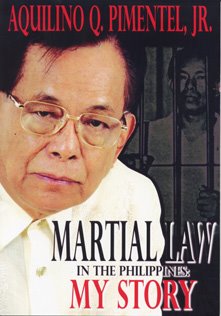 My boss, Senator Nene Pimentel Jr., has recently launched his book titiled "Martial Law: My Story" on June 7 at the historic Manila Hotel.This is the kind of book that should generate a discussion and interest among Filipinos.I attended the launching and I was amazed that the number of dignitaries who graced the ceremonies.Notably, many ambassadors from different countries took turns to make a courtesy chat with Senator Nene while he was busy signing autographs of early readers who got their hardbound copies wrapped in specially designed paper bags.In this book, Nene tells his story of his life and experience during the darks days of martial rule in the Philippines which was riddled with trials, tribulations, and sufferings not only to himself but to his family. H
My boss, Senator Nene Pimentel Jr., has recently launched his book titiled "Martial Law: My Story" on June 7 at the historic Manila Hotel.This is the kind of book that should generate a discussion and interest among Filipinos.I attended the launching and I was amazed that the number of dignitaries who graced the ceremonies.Notably, many ambassadors from different countries took turns to make a courtesy chat with Senator Nene while he was busy signing autographs of early readers who got their hardbound copies wrapped in specially designed paper bags.In this book, Nene tells his story of his life and experience during the darks days of martial rule in the Philippines which was riddled with trials, tribulations, and sufferings not only to himself but to his family. H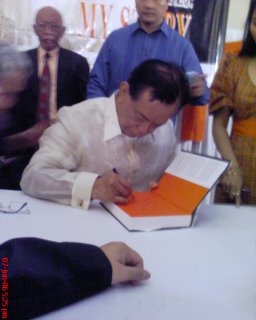 e said he wanted to tell the story of martial law from his own eyes so furture generations will realize the meaning of the phrase "never again."What was startling was that the very top officials of the government that attended the launching were both from the administration and the opposition.Political leaders were crossing party lines on this ocassion.Karl Miranda, my superior in the Senate legislative work, said Nene is the man who can bring members of two opposing political forces together.Who were there?I saw former Vice President Teofisto Guingona, Foreign Affairs Secretary Bert Romulo, colleagues in the Senate like Mar Roxas, Richard Gordon, JambyMadrigal, Congressmen Satur Ocampo, Teddy Casino, professor Randy David, and many others whose faces I am struggling to recall.
e said he wanted to tell the story of martial law from his own eyes so furture generations will realize the meaning of the phrase "never again."What was startling was that the very top officials of the government that attended the launching were both from the administration and the opposition.Political leaders were crossing party lines on this ocassion.Karl Miranda, my superior in the Senate legislative work, said Nene is the man who can bring members of two opposing political forces together.Who were there?I saw former Vice President Teofisto Guingona, Foreign Affairs Secretary Bert Romulo, colleagues in the Senate like Mar Roxas, Richard Gordon, JambyMadrigal, Congressmen Satur Ocampo, Teddy Casino, professor Randy David, and many others whose faces I am struggling to recall. I was annoyed by the comment of Senator Richard Gordon, who jokingly whispered "Magandang racket pala ito. Dapat magsulat din ako (This is a good racket. I should write my own)."To my annoyance, I told him "Magpakulong ka muna, Senator (Have yourself jailed first, Senator)." Perhaps, it would be a book worth reading.The Senator hastily left, pretending not to hear, because Terry Domugho let out a boisterous laugh.
I was annoyed by the comment of Senator Richard Gordon, who jokingly whispered "Magandang racket pala ito. Dapat magsulat din ako (This is a good racket. I should write my own)."To my annoyance, I told him "Magpakulong ka muna, Senator (Have yourself jailed first, Senator)." Perhaps, it would be a book worth reading.The Senator hastily left, pretending not to hear, because Terry Domugho let out a boisterous laugh.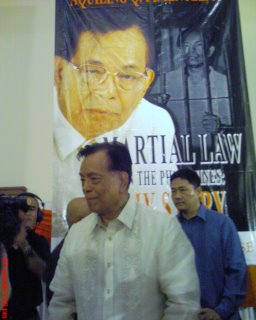 Nene is one of the most prominent figures during martial law at the other side of the fence. Because he fought Marcos to the hilt, perhaps he earned the special ire of the dictator to the extent that he was jailed four times.I have read part of the book during its "early" release so I can make a fairly interesting preview.
Nene is one of the most prominent figures during martial law at the other side of the fence. Because he fought Marcos to the hilt, perhaps he earned the special ire of the dictator to the extent that he was jailed four times.I have read part of the book during its "early" release so I can make a fairly interesting preview. In the book, Nene tells how he was transferred to the cells of hardened criminals, instead of being mixed with fellow political detainees. It was perhaps a strategy of the government to soften Nene from his recalcitrance.What happened was the opposite. Instead of being thrown to the proverbial "lion's den" he found himself in comfortable company, because he easily gained the respect of the most notorious criminals. The hardened inmates immediately saw that Nene was a man who never deserved jail time, and was jailed for a bizzare crime: Fighting for principles. While they were not lawyers, the inmates knew clearly that such a crime does not exist.They found refuge in Nene in their legal troubles because Nene gave them pro bono legal advice of their cases.
In the book, Nene tells how he was transferred to the cells of hardened criminals, instead of being mixed with fellow political detainees. It was perhaps a strategy of the government to soften Nene from his recalcitrance.What happened was the opposite. Instead of being thrown to the proverbial "lion's den" he found himself in comfortable company, because he easily gained the respect of the most notorious criminals. The hardened inmates immediately saw that Nene was a man who never deserved jail time, and was jailed for a bizzare crime: Fighting for principles. While they were not lawyers, the inmates knew clearly that such a crime does not exist.They found refuge in Nene in their legal troubles because Nene gave them pro bono legal advice of their cases.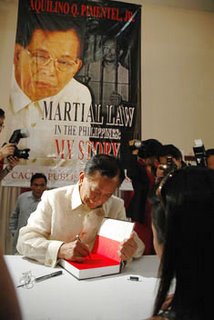 Suddenly, Nene woked mornings with a ready steaming coffee and pan de sal for breakfast at his bedside, aware that it was earnestly handed to him by a generous and grateful "housemate".Also in the book, Nene tells of his weakness. He wrote that while he was fierce in fighting Marcos, he had the hidden weakness of a father longing for the company of his family. Nene felt his heart crumpled everytime his wife, Bing and children would leave afer their jail visitations. But Nene said he just comouflaged this soft spot becuase he didn't want the Marcos guards to discover this and might just deny him precious family visits as leverage.Martial law is one of the bookmarked episodes of Philippine history. It would be worth our while to flip back the pages and get a first hand account from the eyes of a significant player of that time.
Suddenly, Nene woked mornings with a ready steaming coffee and pan de sal for breakfast at his bedside, aware that it was earnestly handed to him by a generous and grateful "housemate".Also in the book, Nene tells of his weakness. He wrote that while he was fierce in fighting Marcos, he had the hidden weakness of a father longing for the company of his family. Nene felt his heart crumpled everytime his wife, Bing and children would leave afer their jail visitations. But Nene said he just comouflaged this soft spot becuase he didn't want the Marcos guards to discover this and might just deny him precious family visits as leverage.Martial law is one of the bookmarked episodes of Philippine history. It would be worth our while to flip back the pages and get a first hand account from the eyes of a significant player of that time.
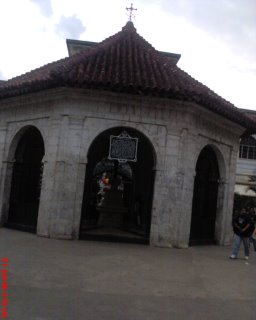 A few days ago, I accidentally ended up visiting the Magellan's Cross which is located right in front of the City Hall of Cebu City.Cebu is known as the Queen City of the South. More than the maginificent tourists destinations, the beach resort with their pristine crsytal waters, Cebu City is the cradle of much of Phlippine history.While on doing official work, I found myself right at the center of Cebu's showcase of its rich history: The Magellan Cross.It is just ironic that, the Magellan's Cross is in a place I have visited perhaps more than a hundred times in my life. But it was the very first time that I stepped into the Magellan's Cross. Worse, it was a purely accidental sojourn. It just so happened that I had some business in the area. For a moment, I felt shame for myself.The Megallan's Cross tells a load of who we are as a people. Visiting the Magellan's Cross will give a glimpse of the Filipino identity.
A few days ago, I accidentally ended up visiting the Magellan's Cross which is located right in front of the City Hall of Cebu City.Cebu is known as the Queen City of the South. More than the maginificent tourists destinations, the beach resort with their pristine crsytal waters, Cebu City is the cradle of much of Phlippine history.While on doing official work, I found myself right at the center of Cebu's showcase of its rich history: The Magellan Cross.It is just ironic that, the Magellan's Cross is in a place I have visited perhaps more than a hundred times in my life. But it was the very first time that I stepped into the Magellan's Cross. Worse, it was a purely accidental sojourn. It just so happened that I had some business in the area. For a moment, I felt shame for myself.The Megallan's Cross tells a load of who we are as a people. Visiting the Magellan's Cross will give a glimpse of the Filipino identity.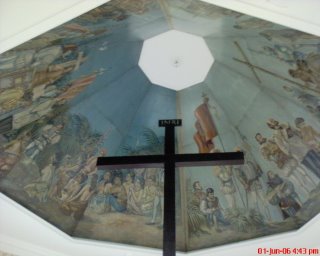 In school we were taught that the Ferdinand Magellan expedition was instrumental in Christianizing a nation, which perhaps in the early times were either pagans or people who worshippped trees.Were it not for Magellan, we would possibly be a Muslim country, as many of our neighbors-nations are dominated by Islam.The name Magellan also denotes Filipino gallantry as history tells us that the browned skinned local warrior called Lapu-Lapu stood up to fight against foregin invaders.What is in the Magellans Cross? From the outside, the Magellan cross looks like a commercial kiosk that is seemingly out of place because it is located in the center of what is like a public park near the city hall.
In school we were taught that the Ferdinand Magellan expedition was instrumental in Christianizing a nation, which perhaps in the early times were either pagans or people who worshippped trees.Were it not for Magellan, we would possibly be a Muslim country, as many of our neighbors-nations are dominated by Islam.The name Magellan also denotes Filipino gallantry as history tells us that the browned skinned local warrior called Lapu-Lapu stood up to fight against foregin invaders.What is in the Magellans Cross? From the outside, the Magellan cross looks like a commercial kiosk that is seemingly out of place because it is located in the center of what is like a public park near the city hall.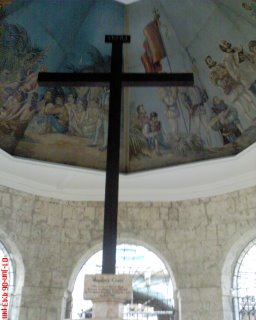 But getting inside tells a great deal of our history.What greeted me, as a visitor was a huge plaque which stated:"FROM TIME IMMEMORIAL THIS SPOT HAS BEEN SET ASIDE TO COMMEMORATE THE ERRECTION OF A CROSS IN CEBU BY THE EXPEDITION OF MAGELLAN. WHEN KING HUMABON OF CEBU AND HIS QUEEN, SON AND DAUGHTERS, TOGETHER WITH SOME 800 OF THEIR SUBJECTS WERE BAPTIZED BY FATHER PEDRO VALDERRAMA. THIS HALLOWED SITE WAS IMPROVED IN 1735 BY REV. JUAN ALBARRAN, PRIOR OF SAN AGUSTIN AND IN 1834 BY RT. REV. SANTOS GOMEZ MARANON, BISHOP OF CEBU. THE IMAGE OF THE STO. NINO FOUND BY THE EXPEDITION OF LEGASPI IN A HOUSE NEAR THE PRESENT SITE OF THE CATHDERAL OF CEBU IS VENERATED BY THE FAITHFUL IN THE NEARBY CHURCH OF SAN AGUSTIN."Inside the kiosk is a wooden cross and the ceiling is painted with images of religious figures, friars, who seem to be introducing the Roman Cahtolic religion to the natives.The Magellan's cross is probably a place you will definitely miss to see when you are in Cebu. But in your next visit, it would be helpful to stop and ponder. The Magellan's Cross tell much of why you became who you are today.
But getting inside tells a great deal of our history.What greeted me, as a visitor was a huge plaque which stated:"FROM TIME IMMEMORIAL THIS SPOT HAS BEEN SET ASIDE TO COMMEMORATE THE ERRECTION OF A CROSS IN CEBU BY THE EXPEDITION OF MAGELLAN. WHEN KING HUMABON OF CEBU AND HIS QUEEN, SON AND DAUGHTERS, TOGETHER WITH SOME 800 OF THEIR SUBJECTS WERE BAPTIZED BY FATHER PEDRO VALDERRAMA. THIS HALLOWED SITE WAS IMPROVED IN 1735 BY REV. JUAN ALBARRAN, PRIOR OF SAN AGUSTIN AND IN 1834 BY RT. REV. SANTOS GOMEZ MARANON, BISHOP OF CEBU. THE IMAGE OF THE STO. NINO FOUND BY THE EXPEDITION OF LEGASPI IN A HOUSE NEAR THE PRESENT SITE OF THE CATHDERAL OF CEBU IS VENERATED BY THE FAITHFUL IN THE NEARBY CHURCH OF SAN AGUSTIN."Inside the kiosk is a wooden cross and the ceiling is painted with images of religious figures, friars, who seem to be introducing the Roman Cahtolic religion to the natives.The Magellan's cross is probably a place you will definitely miss to see when you are in Cebu. But in your next visit, it would be helpful to stop and ponder. The Magellan's Cross tell much of why you became who you are today.
 One of the fastest-rising provinces in the country is the former war-ravaged province of North Cotabato.
One of the fastest-rising provinces in the country is the former war-ravaged province of North Cotabato. "Not long ago, North Cotabato has been known as a garbage dump. In this province you witness endless war between government troops and all types of rebels" Pinol said.
"Not long ago, North Cotabato has been known as a garbage dump. In this province you witness endless war between government troops and all types of rebels" Pinol said. But now, Pinol said he is proud to showcase North Cotabato was one of the fastest growing economy in the south.
But now, Pinol said he is proud to showcase North Cotabato was one of the fastest growing economy in the south. The only way to establish lasting peace is to eradicate poverty and want.
The only way to establish lasting peace is to eradicate poverty and want. This is the only way peace can be achieved, Pinol stressed.
This is the only way peace can be achieved, Pinol stressed.  People in imperial Manila have no idea on how to place our province on the path to progress. We have to chart our own destiny, Pinol maintains.
People in imperial Manila have no idea on how to place our province on the path to progress. We have to chart our own destiny, Pinol maintains. That is why he said he has adopted simple formula to remove North Cotabato from the list of poor provinces.
That is why he said he has adopted simple formula to remove North Cotabato from the list of poor provinces. Now, North Cotabato is one of the largest producers of banana, focusing on the Lakatan variety. Pinol reported that
Now, North Cotabato is one of the largest producers of banana, focusing on the Lakatan variety. Pinol reported that 
















